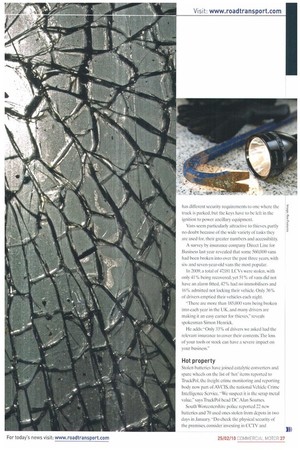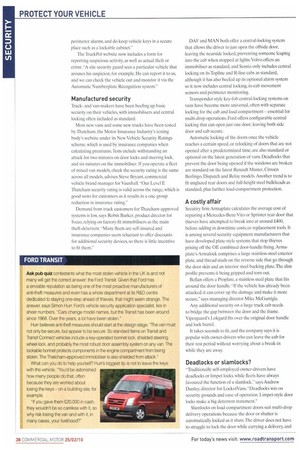Crime bust
Page 36

Page 37

Page 38

Page 39

If you've noticed an error in this article please click here to report it so we can fix it.
If you are aware of the security risks your company faces and prepare for them, you have a fighting chance of outwitting thieves.
Words: Sharon Clancy
Trying to protectri your prized assets from the attention of the criminal fraternity is not an easy task.There are so many potential threats to guard against, from opportunistic or planned theft of the load or vehicle, to professionals targeting components for their scrap metal value.
Although modern vehicles are more intrinsically secure (widespread fitting of immobilisers has done a lot to help), security experts advise operators that they should still assess the risk to the vehicle or load posed by the actual operation.
Is the load and access to it the issue, or is it equipment in the cab, whether the radio, sat-nay, phone or MP3 player? Is the vehicle parked in a secure place overnight, or is it parked on a drive?
A local van delivery operation that involves 70 drops a day is vulnerable in a different way to one kitted out for service work, with plenty of tools and equipment. Similarly, a truck on trunking operations
has different security requirements to one where the truck is parked, but the keys have to be left in the ignition to power ancillary equipment.
Vans seem particularly attractive to thieves, partly no doubt because of the wide variety of tasks they are used for, their greater numbers and accessibiliK A survey by insurance company Direct Line for Business last year revealed that some 560,000 vans had been broken into over the past three years, with sixand seven-year-old vans the most popular.
In 2009,a total of 47,181 LCVs were stolen, with only 41')/0 being recovered, yet 51% of vans did not have an alarm fitted, 42% had no immobilisers and 16% admitted not locking their vehicle. Only 36% of drivers emptied their vehicles each night.
"There are more than 185,000 vans being broken into each year in the UK, and many drivers are making it an easy earner for thieves,reveals spokesman Simon Henrick.
He adds: "Only 33% of drivers we asked had the relevant insurance to cover their contents.The loss of your tools or stock can have a severe impact on your business."
Hot property Stolen batteries have joined catalytic converters and spare wheels on the list of 'hot' items reported to Truck Pot, the freight crime monitoring and reporting body now part of AVCIS, the national Vehicle Crime Intelligence Service. "We suspect it is the scrap metal value," says TruckPol head DC Alan Soames.
South Worcestershire police reported 22 new batteries and 70 used ones stolen from depots in two days in January. "Do check the physical security of the premises, consider investing in CCTV and
perimeter alarms, and do keep vehicle keys in a secure place such as a lockable cabinet."
The TruckPol website now includes a form for reporting suspicious activity, as well as actual theft or crime. "A site security guard sees a particular vehicle that arouses his suspicion, for example. He can report it to us, and we can check the vehicle out and monitor it via the Automatic Numberplate Recognition system.
Manufactured security
Truckand van-makers have been beefing up basic security on their vehicles, with immobilisers and central locking often included as standard.
Most new vans and some new trucks have been tested by Thatcham, the Motor Insurance Industry's testing body's website under its New Vehicle Security Ratings scheme, which is used by insurance companies when calculating premiums. Tests include withstanding an attack for two minutes on door locks and steering lock, and six minutes on the immobiliser. If you operate a fleet of mixed van models, check the security rating is the same across all models, advises Steve Bryant, commercial vehicle brand manager for Vauxhall. "Our Level E Thatcham security rating is valid across the range, which is good news for customers as it results in a one-group reduction in insurance rating."
Demand from truck customers for Thatcham-approved systems is low, says Robin Barker, product director for Iveco, relying on factory-fit immobilisers as the main theft-deterrent. "Many fleets are self-insured and insurance companies seem reluctant to offer discounts for additional security devices, so there is little incentive to fit them." DAF and MAN both offer a central-locking system that allows the driver to just open the offside door, leaving the nearside locked, preventing someone leaping into the cab when stopped at lights. Volvo offers an inunobiliser as standard, and Scania only includes central locking on its Topline and R-line cabs as standard, although it has also beefed up its optional alarm system so it now includes central locking, in-cab movement sensors and perimeter monitoring.
Transponder-style key-fob central-locking systems on vans have become more universal, often with separate locking for the cab and load compartment — essential for multi-drop operations. Ford offers configurable central locking that can open just one door, leaving both side door and cab secure.
Automatic locking of the doors once the vehicle reaches a certain speed, or relocking of doors that are not opened after a predetermined time, are also standard or optional on the latest generation of vans. Deadlocks that prevent the door being opened if the windows are broken are standard on the latest Renault Master, Citroen Berlingo. Dispatch and Relay models. Another trend is to fit unglazed rear doors and full-height steel bulkheads as standard, plus further load-compartment protection.
A costly affair
Secutiry firm Armaplate calculates the average cost of repairing a Mercedes-Benz Vito or Sprinter rear door that thieves have attempted to break into at around VIA before adding in downtime costs, or replacement tools. It is among several security equipment manufacturers that have developed plate-style systems that stop thieves prising off the OE combined door-handle fixing. Arrnaplate's Armalock comprises a large stainless-steel exterior plate, and thread studs on the reverse side that go through the door skin and an interior steel backing plate. The slim profile prevents it being gripped and torn out.
Bellan offers a Proplate, a stainless steel plate that fits around the door handle. "If the vehicle has already been attacked, it can cover up the damage and make it more secure," says managing director Mike McGarrigle.
Any additional security on a large truck cab needs to bridge the gap between the door and the frame. Viperguard's Lokgard fits over the original door handle and lock barrel.
It takes seconds to fit, and the company says it is popular with owner-drivers who can leave the cab for their rest period without worrying about a break-in while they are away.
Deadlocks or slamlocks?
-Traditionally self-employed owner-drivers have deadlocks or limpet locks, while fleets have always favoured the function of a slamlock," says Andrew Dunley, director for Locks4Vans."Deadlocks win on security grounds and ease of operation. Limpet-style door locks make a big deterrent statement."
Slamlocks on load-compartment doors suit multi-drop delivery operations because the door or shutter is automatically locked as it shuts.The driver does not have to struggle to lock the door while carrying a delivery, and even if he forgets, the load area is locked as soon as the door closes.
Locks4VansT-series slamlock and deadlocks are Thatcham-accredited. Both the original barrel and the interlock mechanism are replaced. "Some cheap slamlocks upgrade the manufacturer's lock by adding springs, but this does not increase protection to the door against attack," says Dunley.
BeIlan's Armadillo lock is a lightweight version of externally mounted limpet-style locks for doors. "Limpet locks can distort the hinges of the door to which they are attached, causing the door to drop The Armadillo is made from light aircraft-grade materials and has interlocking sections," says McGarrigle."The 'return' section with the lock mechanism fits over a ridged 'keep' section that prevents doors being prised open."
Proximity devices allow the engine to lickover without the keys being in the ignition. The driver wears a transponder on a belt or around his neck. If a thief attempts to move the vehicle without inserting the key, the engine stalls as soon as it is out of range of the transponder. •




































































































































